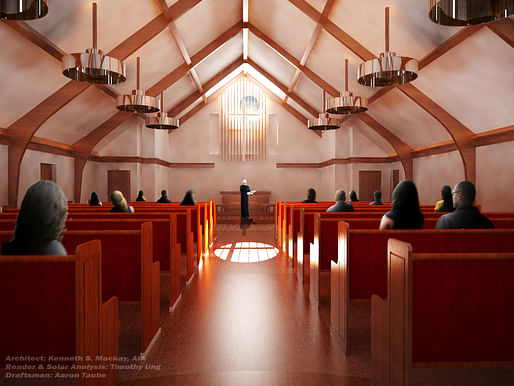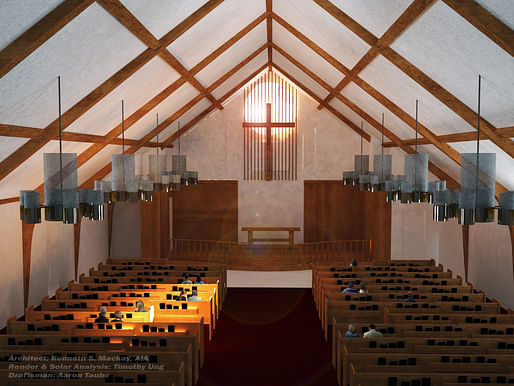
Contributed By: Timothy Ung, M.Arch Student
While helping architect Kenneth S. Mackay digitize his hand-drawn project, St. Peter’s Episcopal Church in Buffalo, New York, I was intrigued by the proposal for a cone-shaped window to flood the space with even amounts of light. During various times of the day, light would enter from the exterior and reflect off of the rounded surface of the cone and into the space, spreading even amounts of light to the other side of the church.
With the help of a junior in the school of architecture at SUNY at Buffalo, Aaron Taube, the hand-drawn project was modeled in Rhinoceros. To analyze the lighting levels across the floor of the church, I brought the digital model into Ecotect and analyzed the daylight levels. The average daylight level in the room was 5 at approximately 30 inches off of the ground.

Ecotect Analysis showing the Daylight Factor 30 inches off of the ground
Next, I rendered the project in V-Ray without having seen the actual built work. Architectural renders are often difficult when it comes to capturing natural lighting and photorealism. Using a base rendering with lighting levels and details, the final image was produced in Adobe Photoshop where people were added to the image. Keeping in mind that I’ve never visited the renovated church, the render came out very similar to an image taken weeks later by Aaron Taube.
 Initial Aisle View Render
Initial Aisle View Render
After revising the digital model and correcting lighting fixtures and other details that were missing from the drawings, I adjusted the lighting condition in Rhinoceros and setup multiple views for rendering. The final renders were made using V-Ray for Rhinoceros and brought into Adobe Photoshop to post-process the image and obtain a photorealistic image. Lighting placement, camera adjustments such as ISO’s, Lens zoom, Shutter Speed, and F-stop’s are vital in the V-Ray options to capture realistic lighting, shadows, and details within the digital model. The post-processing phase in Photoshop is crucial because the addition of people and shadows add life to the image.  Final Balcony View Render
Final Balcony View Render
 Final Aisle View Render
Final Aisle View Render
 Final Seat View Render
Final Seat View Render
Learn more about the research and creative activities of our enterprising students and faculty. At the School of Architecture and Planning, we engage with our local and global communities to push the boundaries of our disciplines and innovate the professions of architecture and planning.
1 Comment
Having worked in the visualization field, I know the pain of trying to capture photorealistic lighting qualities in renderings. The controller adjusting and rerendering process is time consuming and sometimes very frustrating. To save time, a lot of these adjustments can occur in post-process.
The renderings look nice, the way the daylight comes in and is casted on the floor in the initial view is a nice touch.
Block this user
Are you sure you want to block this user and hide all related comments throughout the site?
Archinect
This is your first comment on Archinect. Your comment will be visible once approved.